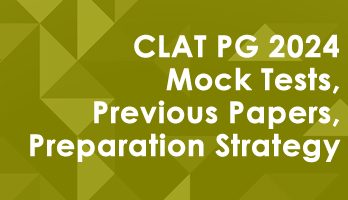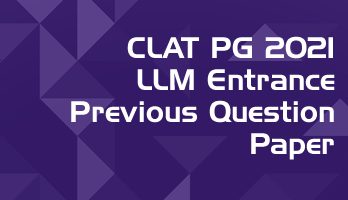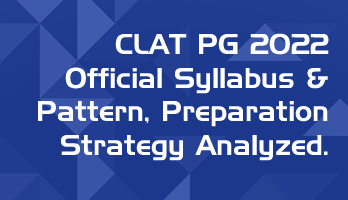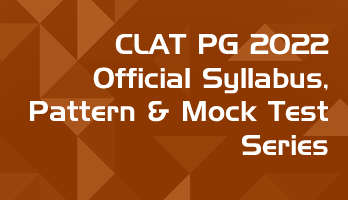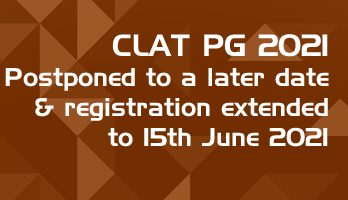The NLSIU NLAT PG will be conducted as a proctored home based exam, we have compiled a list of FAQs, Do’s & Dont’s and best practices to help you prepare in advance.
Note that these are generic guidelines applicable to most home based online proctored exams and you should refer to the official instructions for NLSIU NLAT to comply with the specific requirements.
Update : We have also included the official FAQs at the end of this article.
What is an online proctored exam?
The NLSIU NLAT will be conducted in online mode; and the test takers will be monitored by a ‘Proctor’ – which can either be :
- a real person who monitors students during an examination via video and audio OR
- a proctoring software, which monitors your computer’s desktop, webcam video and audio OR
- a combination of a real person monitoring multiple test takers, with proctoring software evaluating the video and audio for suspicious behavior
NLSIU has confirmed that the NLAT 2020 shall be conducted using a combination of technological, Artificial Intelligence-based proctoring, as well as human proctoring.
How will the integrity of the exams be assured by online proctoring?
With a number of exams moving to an inline mode, AI powered proctoring systems have also become quite adept at detecting any suspicious activity. In general, robust proctoring systems can use up to three levels of controls :
- Real time AI powered software based proctoring – which monitors audio, video and system parameters – can detect facial expressions, eye movements, mobile phones & other equipment, presence of multiple people.
- Human proctoring – where a supervisor can monitor multiple test takers simultaneously.
- Recording and Review of the exam process – so that any suspicious behavior reported by the proctors can be investigated.
Recently, there were some videos showing test takers cheating in online entrance exams. However, that is not proof that they succeeded in gaining an unfair advantage.
In most cases, a person cheating in an online proctored exam will be allowed to complete the exam even though the software and / or human proctor have detected suspicious activity.
However, since all attempts are recorded, flagged off cases can be subsequently reviewed and the results are withheld or invalidated.
What is the recommended place for taking the exam?
You will need a reliable internet connection, a relatively private location with minimal disturbance and a well-lit surrounding.
A bedroom or a study room or an office room where you will not be disturbed for the duration of the exam is essential.
Can I take the exam from any location?
If there are no specific restrictions by NLSIU, online proctored exams can be taken from anywhere.
If you expect connectivity issues or don’t have the required privacy at home, you can take the exam from any other location – a friend or relative’s house.
In fact, for some other proctored exams, we have seen students booking hotel rooms for a day just for ensuring good connectivity and privacy.
Will the NLSIU NLAT exam session be recorded?
Usually, proctored exam sessions are recorded for review. The webcam video, audio and system data may be recorded for subsequent audit in case of any discrepancies, suspicious actions or concerns.
However, the test takers are not be allowed to record the exam session.
What devices can be used for taking the NLSIU NLAT exam?
Depending on the proctoring process and software they are implementing, NLSIU will confirm the specific details of the equipment that can be used by the test takers.
In general, most Proctoring systems are designed to run on a standard desktop or laptop computer, with a single monitor or display.
Mobile phones, Android Tablets or iPads are usually not supported and not recommended.
If possible, connect your computer and WiFi router to a UPS to prevent power related interruptions.
Do you need a webcam and microphone?
Proctored exams usually require the usage of a webcam and microphone, either a default device built into your computer or an external device.
The proctor or exam software may also check and record your computer’s display settings to ensure that duplicate displays (multiple monitors) are not being used.
Considering that there will be long paragraphs to read; a laptop with a bigger screen or a desktop will be useful. In addition, an external mouse will help in easier navigation through the exam screens.
Will you require any specific software for the proctored exam?
Proctored exams may require you to install and use a specific software on your PC for the duration of the exam. The exam may also use special browsers like ‘Safe Exam browser’ : https://safeexambrowser.org/news_en.html
While the official notification will confirm the platforms that can be used, we strongly recommend using a Windows 10 based laptop or desktop; since some proctoring systems may have compatibility issues with MacOS or Linux.
If you are a Mac user, consider borrowing a Windows laptop for the duration of the exam or installing Windows on your Macbook through the official Apple Bootcamp process.
Is broadband internet required for online exams?
Generally, online exams are designed to work with normal internet bandwidth. The ‘minimum system requirements’ should be specified by NLSIU when the official details are published. In addition, students should make use of the official mock tests to confirm their system compatibility.
Since the actual exams will require audio and video streaming for the proctoring, higher bandwidth is always beneficial.
Do you require any documentation while taking the exam?
Typically, you may be required to have an approved photo ID proof with you during the exam. E.g. Passport, Aadhaar etc.
Hall ticket may also be required if specified by NLSIU.
You should not have any other documents (written or printed) in the room. Ensure that any books, magazines, newspapers, posters and any other documents are removed from the room where you are taking the exam.
Can you use any rough work sheets?
Refer to the official instructions. As such, rough work sheets are not allowed in most proctored exams.
Some exams may allow test takers to use clear plastic sheets or laminated white sheets to be used for rough work, with an erasable dry marker pen.
DO NOT bring any rough sheets into the room where you are taking the exam unless specifically allowed in the official instructions.
Ensure you have a hand-mirror or a portable wall mirror handy.
In most exams, the Proctor or the software will need to see (and record) the physical screen of your computer and the surroundings of the room where you are taking the exam.
Usually, this can be accomplished by moving around (panning) the webcam on your device or by using a mirror to show the surroundings, the area behind the monitor, the space under the desk etc.
Remove all clutter from your exam room.
Remove any materials that are not required for your exam including any sheets, clothes, pillows, wall hangings etc.
Keep the area underneath your table clear.
Can I wear a smart watch or have a clock with me?
No. Digital watches, smart watches, digital clocks, tablets and any other devices with a digital display should be removed from the room. While normal analog watches may be allowed in some exams, refer to the official instructions.
Can I wear headphones, smart glasses, ear buds or any wireless devices during the exam?
No. Using any type of wireless or wired audio visual device not specifically required for the exam may lead to disqualification.
Can I have water or eatables with me?
Water in clear plastic bottles may be allowed, however eatables may not be allowed during the exam. If you have any medical requirements, reach out to NLSIU to check for any exceptions.
In general, we suggest that you should not have any food or water near your during the 40 minutes of the exam time.
Can I take a toilet break during the exam?
In most proctored exams, you are not allowed to take a break or even get up from your chair for the duration of the exam. Plan accordingly.
Precisely follow the instructions and the communication protocol that will be specified by NLSIU. There may be an option to speak with the proctor for exam related clarifications.
Do not indulge in any extraneous conversations with the proctor.
What should I check before the NLSIU NLAT exam?
- Run any system updates on your computer beforehand and pause automatic updates for the day if possible.
- Test the exam software and website in advance
- Uninstall any games and extra software – to prevent any pop-ups or interruptions during the exam
- Switch off WiFi in all other devices (E.g. Phones, Alexa / Google devices) to ensure maximum bandwidth for your exam. Consider changing WiFi password for the duration of the exam to prevent any connections using bandwidth during the exam period.
- Reboot your internet router and computer an hour before the exam to ensure a better connection and optimum experience
Note : This article will be updated as and when official instructions are published by NLSIU. Always refer to the NLSIU official website for the most updated and authentic information about the exam. The notes in this article are just an unofficial compilation to help students understand what to expect.
If you have any specific questions or comments; send us a mail to hello@lawmint.com
Official FAQs from the NLSIU website notification :
What is the deadline for applying to NLSIU this year?
NLSIU, Bengaluru will conduct the National Law Aptitude Test (NLAT), 2020 for admission to its undergraduate B.A., LL.B. (Hons) and postgraduate LL.M. programmes for the year 2020-21 on September 12, 2020.
Applications open September 3, 2020 and close at midnight on September 10, 2020. Candidates may submit their applications for the NLAT 2020 at: https://admissions.nls.ac.in/
Announcements regarding the admission process and counselling will follow after NLAT. For more details of the NLAT please visit: https://admissions.nls.ac.in/
Will NLSIU participate in the CLAT 2020? If NLSIU conducts the NLAT, will they consider CLAT 2020 scores for admission?
The Admissions Notification published on the NLSIU website exclusively governs all admissions to the B.A., LL.B (Hons) and LL.M. Programmes of NLSIU for the year 2020-21. Any student who seeks admission to NLSIU must apply directly to the University and complete the NLAT 2020 Entrance examination.
The University will not accept CLAT 2020 scores for admission to Academic Year 2020-21.
Will there be a refund of CLAT application fees?
NLSIU cannot comment on any aspects of the CLAT 2020. Any queries or requests in this regard may be directed to the appropriate authorities in the CLAT Consortium.
How does NLSIU propose to conduct the NLAT 2020 in a manner that prevents malpractices?
The NLAT 2020 will use a combination of AI-based and human proctoring. Additionally, the test structure has been designed in a manner that minimises the possibility of candidate malpractices.
This includes candidates not being able to revisit a question that they have already viewed and moved past and the randomisation of the sequence in which questions are displayed to candidates.
Furthermore, the questions for the NLAT 2020 have been drafted in a manner that requires interpretative answers, which minimises the utility of referring to the internet or other sources for answers.
How does NLSIU propose to maintain transparency if the merit list is not being published?
The vendor engaged by the University will provide detailed reports to the University upon the conclusion of the examination. These include a subject-level score breakdown, as well as whether any possible malpractices have been detected.
Each candidate shall be informed of their merit rank individually.
A grievance redressal process shall be established that any candidate may use to raise challenges if they wish to do so. The University is committed to a fair examination process, and will continue to make efforts for this.
Why does the NLAT 2020 have negative marking for unanswered/ un-attempted questions?
The NLAT 2020 aims to test depth of preparation and recognise those candidates who have the combination of skills and abilities that the University seeks in incoming students.
Negative marking for unanswered questions in the present format of the NLAT 2020 (home-based, remote proctored, and shorter format) will help ensure those candidates who have prepared more comprehensively are able to score better than those that have not.
Will the NLAT 2020 be a proctored test? How will the proctoring be conducted?
The NLAT 2020 will be proctored through a combination of technological, Artificial Intelligence-based proctoring, as well as human proctoring.
The necessary personnel to ensure human proctoring is being provided and trained by the vendor engaged by the University for the NLAT 2020 so as to ensure the examination is conducted in as smooth and fair a manner as possible. The vendor has experience conducting large-scale examinations in similar formats.
What is the rationale behind the lower number of questions in the NLAT 2020 as compared with the CLAT 2020, and the shorter duration of the NLAT 2020?
The examination structure of the NLAT 2020 aims to minimise the possibility of malpractices, and a shorter-format examination assists towards this in a home-based testing environment.
This was also in response to infrastructural concerns. In addition, certain changes have been made to the question paper structure for the undergraduate paper that ensure a deeper testing of the skills and aptitude that the NLAT 2020 aims to evaluate.
While the CLAT 2020 is proposed as a 2-hour examination, the NLAT 2020 is of a shorter duration for the reasons described and because it has fewer questions than the proposed format of the CLAT 2020.
Why does the NLAT 2020 not permit candidates to review/ revisit questions?
This is one of the measures taken to prevent candidate malpractices. In combination with the scoring pattern of the NLAT 2020 and the randomised sequencing of question sets for each candidate, this will help towards preventing unauthorised collaboration among candidates and among candidates and others.
What is the rationale behind the scoring system for the NLAT 2020?
The NLAT 2020 tests speed as well as accuracy and depth of preparation. The proposed scoring system will help ensure that candidates do not attempt to guess at the correct answer; further, in combination with a shorter format and fewer questions, this helps ensure that deeper preparation is recognised and rewarded.
Will Persons With Disabilities be able to avail the services of a Scribe?
Yes. PWD candidates with benchmark disabilities of the following types – visual impairment, cerebral palsy and locomotor disability (both arms affected) – are entitled to avail the services of a Scribe.
PWD candidates with other types of benchmark disabilities (other than visual impairment, cerebral palsy and locomotor disability (both arms affected)) are entitled to avail the services of a Scribe, provided they submit appropriate medical certificates to the effect that the candidate has a physical limitation to write, as per the pro forma provided here ( Appendix I).
Does the Scribe need to submit any additional documents?
PWD candidates will be required to choose their own Scribe and submit a Letter of Undertaking (provided here – Appendix II), ensuring:
a. The minimum educational qualification of the Scribe is matriculation (Class 10 pass) or equivalent.
b. The maximum educational qualification of the Scribe does not exceed the candidate’s own qualifications.
The Scribe will also need to submit a picture of a Government ID.
Will I get additional time if I am a PWD candidate?
Yes. All PWD candidates with benchmark disabilities shall be provided additional/ compensatory time of 15 minutes (for both, the NLAT 2020 UG and PG tests) to complete the NLAT 2020; this includes PWD candidates who avail the services of a scribe.
What efforts is NLSIU making to ensure the technical requirements/ specifications for the NLAT 2020 do not exclude a larger number of candidates from appearing for the test?
NLSIU has closely monitored the comments and queries that NLAT candidates have communicated to us in relation to the technical specifications/ requirements for the NLAT 2020, and have been working proactively with the vendors engaged for the NLAT 2020 to make the test accessible to as large a number of candidates as possible. Towards this end:
(i) The NLSIU team is working closely with the vendors engaged for the NLAT 2020 to explore options that reduce the Internet bandwidth requirement for the NLAT 2020 to 512 kbps. Further, we are also making an effort to ensure:
(ii) the NLAT 2020 is accessible to candidates using Mac OS as well as Linux computers in addition to Windows computers, and
(iii) the NLAT 2020 is accessible to candidates using Android mobile devices.We are also preparing suitable modifications to the proctoring protocols for the NLAT 2020 to ensure these changes do not compromise test integrity in any manner.
If I do not have the facilities necessary to appear for the NLAT 2020 at my home, can I take the NLAT 2020 at another place where the necessary facilities are available?
Yes, if the alternative venue you wish to take the NLAT 2020 from complies with the test protocols published, you can appear for the NLAT 2020 from such other locations.
It is not necessary that you take the NLAT 2020 exclusively from your home or the address you have provided in your Application Form – you can appear for the NLAT 2020 from any location that meets the requirements published.
Refer to this article for details about the application process, timelines, syllabus and other details of the NLSIU NLAT exam : https://lawmint.com/clat-pg-llm/nlsiu-nlat-pg-model-paper-mock-test-series/





